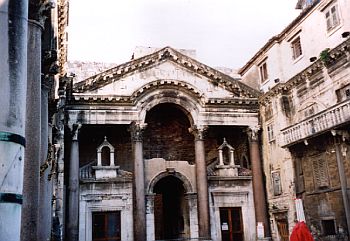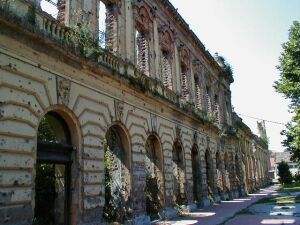History - a short overview
Present-day Croatia as well as the surrounding area was first inhabited by Illyrian tribes, to be followed by ancient Romans. The colonization probably started at the Dalmatian coast near →Split; a city, which eversince plays an important role in the history of Croatia. After the Roman Empire had been divided into East and West in 395 AD, Croatia, together with present-day →Bosnia and →Slovenia, became part of the Western Roman Empire. On the other hand, →Serbia, →Macedonia and so on had been taken over by the Byzantine Empire. Since the 6th century, first Slavic tribes settled in the area. The strongest tribe among them was the Slavic tribe of the Croats. Later on, the northern part belonged to the Frankish kingdom, whereas the south was conquered by the Byzantine empire. In 925, the northern and the southern part merged together to form the Kingdom of Croatia.
The newly formed kingdom prospered for around 200 years. After that, the northern part decided to unite with →Hungary. The southern part, ie Dalmatia, was taken over by strong Venetia. This shouldn't change during the next centuries. However, in the years 1241/2, a vast horde of Mongols (see also →History of Hungary) devastated the entire area. The Ottoman empire, successor to the Byzantine Empire, gradually invaded almost all of the Balkans, but it never conquered Dalmatia. In contradiction to that, the north of Croatia became part of the Habsburg monarchy after the defeat of the Ottomans over Hungary in 1526. Logically, northern Croatia later on became a province of Austria-Hungary. At that time, many so-called Krajina-Serbs (Krajina means border) were settled in the area along the border with the Ottoman Empire in order to secure the border. The Serbs of the Krajina were about to play an important but tragic role in the 1990ies. The history of →Dubrovnik was an exception to the rest of Croatia - for a very long time, Dubrovnik was able to remain independent as the so-called Republic of Ragusa.

| ||
| 1,700 yrs old Diocletian's Palace in Split |
At the beginning of the 19th century, the whole region was overrun by Napoleon, but the French occupation didn't last long. After the retreat of the French armies, Austria-Hungary used the vacuum to occupy Dalmatia. By doing this, entire present-day Croatia became part of the vast Austro-Hungarian Empire. This shouldn't change until the defeat of the monarchy in 1918. However, starting in the middle of the 19th century, the Croatian middle classes grew stronger and therefore Croatian nationalism was undergoing its revival. Shortly after the end of World War I, Croatia together with Serbia and Slovenia founded the Kingdom of Serbs, Slovenes and Croats, which was renamed Yugoslavia in 1929. Apparently, many Croats were not very happy with this union. The resistance grew stronger and culminated in the assassination of the Serbian king Alexander I. in Marseilles in the year 1934 by Croatian nationalists. Things got even worse after the occupation by Nazi-Germany in 1941. In Croatia, a fascist organization called Ustaşa (Ustasha) gained control over the country and immediately started to expel and annihilate Serbs, Roma, Moslems and other minorities. Even the infamous German SS complained about the brutality of Ustasha troops. There were also Croats joining the partisans in their struggle against the Nazis, but generally spoken it was a grim fight between Ustaşa (=Croats) and Četniks (=Serbs). It would be wrong to say that massacres were only committed by Croats and not by Serbs, but the Croatian extermination machinery was the most devastating one. Only in Croatia and Bosnia, around one million people lost their lives during the World War II.
It is one of the miracles of the 20th century, that, despite all the hatred and killings, Yugoslavia re-formed soon after the end of WWII - this time under the wings of the Soviet Union and the reign of the Croatian-Slovenian governor Marshal Tito and a central government in →Belgrade. After the death of Marshal Tito in 1980, Yugoslavia started to crumble. The political situation became gradually unstable; additionally, a big regional gap in the affluence of Yugoslavs marked another source of annoyance (as it does in other countries, eg Italy). To be more exactly, the standard of living in →Slovenia and Croatia was much higher than in the rest of Yugoslavia. After the beginning of Glasnost', the Perestroika and the fall of the Berlin Wall, first democratic elections were held in Croatia in 1990. This election was won by a non-communist, namely Franjo Tudjman, a former partisan general and leader of the Croatian Democratic Union.

| ||
| Completely destroyed: Vukovar in East Slavonia |
As a result of the election, Croatia declared its independence in 1991 and granted minority status to the Serb minority in Croatia. However, for some reason Serbs were not granted special rights. As a matter of fact, things got worse for Croatian Serbs. And so the Serb minority, not less than 600,000 people, voted for autonomy. To complicate things, Serbs of the Krajina immediately declared independence from Croatia after Croatia itself declared its independence. This unrecognized patch of land was called Republika Srpska Krajina (RSK) and consisted of three regions not being connected with each other - a part of West Slavonia, East Slavonia and the Krajina itself, which is the area close to the north-west border of Bosnia & Herzegovina. Capital of the RSK was the rather small town of Knin. Soon after the declaration of independence, the conflict was about to escalate. Bosnian Serbs as well as the JNA - the Yugoslav National Army, dominated by Serbs - rushed to the Krajina to protect the Serbs. This involved some 180,000 soldiers and around 2,000 tanks. The Krajina Serbs, occupying the area between Dalmatia and the rest of Croatia, used their strategically important position to cut off vital connections within Croatia. Heavy fights in the Krajina and in Slavonia, esp around →Vukovar, broke out. Vukovar was beleaguered by 30,000 soldiers and 600 tanks, before it surrendered after 3 months.
Within three months, the Yugoslav National Army seized around ¼ of the entire country. As a countermeasure, Croatia blocked all JNA barracks on its territory. In order to lift the blockade, the JNA, now an alliance between Serbia and Montenegro, started to attack Southern Dalmatia around →Dubrovnik. The latter was besieged and came under heavy mortar shelling. Meanwhile, Serbian jet fighters attacked →Zagreb, trying to kill the Croatian president. They didn't succeed, but some civilians were killed. In 1995, negotiations about a truce were brought to a grinding halt. Croatia concentrated its forces in the military operation Blijesak (lightning) and recaptured West Slavonia. Less than three months later, Croatia started another campaign called Oluja (storm) to recapture the Krajina. Only East Slavonia around →Vukovar remained under Serbian control. As a result of the military operations, more than 100,000 Serbs had to flee their homes in an instant. The Dayton Accord of 1998 settled the unsolved conflict over East Slavonia. Serbia had to hand over East Slavonia, but the Serbs - even today more than 50% of the population there - are allowed to stay in East Slavonia, protected by international observers. Croatia with its present borders is internationally recognized.
The country is recovering more or less quickly. This is also thanks to the tourists coming back to Croatia. Today, there's a strong cooperation between the European Union and Croatia. The economy is booming, although unemployment in some areas exceeds 20%. However, the most important thing at the moment is the stabilization of the political situation of Croatia and the neighbouring countries.
©2024 Europe-East.com

 Albania
Albania Croatia
Croatia